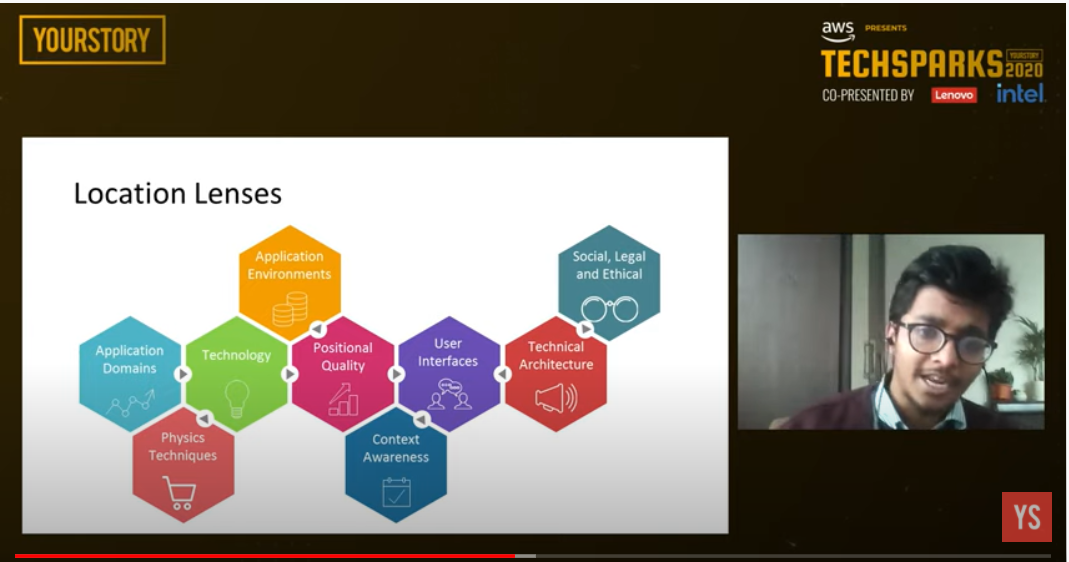Today, we think nothing of jumping into our cars, entering our destination and being voice guided by our phone’s mapping software till we get there. Mapping and location services have become increasingly ubiquitous with the widespread adoption of smartphones. For businesses, location technologies and location intelligence have become essential. Understanding and analysing location accurately can aid better decision-making for businesses of all sizes.
In line with this, Rishi Bhammar, Senior Product Manager, Cisco; and Siddharth Desai, Co-founder, Clean Slate Technologies, conducted a masterclass session on location and location intelligence at the 11th edition of YourStory’s flagship event, TechSparks.
According to Rishi, it does not matter how accurate one can get with location technology. What really matters is that this accuracy is actually determined by the application need.
“We need to ensure that we have the ability to very cleanly identify and quantify what our application needs are. And that essentially will lead to data mining and the required technology stack,” he said.
Here are some use cases of location technology that were discussed during the masterclass.
Low-fidelity use cases: Rishi gave the example of leveraging location intelligence within neighborhoods. The application here is hyper-targeted advertisements in social media. So, when a person logs into his or her Facebook/Twitter account, the various algorithms running at the backend can target the consumer for using hyperlocal advertising based on their current location, area specified on their profile, or past social posts.
“The marketers leveraging location intelligence here don’t really need to know the exact building the consumer is in front of. They just need to know about the user’s neighbourhood or pincode at the moment he/she is around to better target the hyperlocal ads,” added Rishi.
High-fidelity use cases: GPS usually helps with navigation inside a neighbourhood or across a city. But more precise data elements are needed when it comes to use cases at play inside buildings and campuses and zone-based tracking comes into play.
“Time tracking, footfall counting, counting people during an emergency evacuation, taking care of people’s safety at a remote location — when you start moving closer and closer to the center of that circle, you start looking at zonal analytics,” said Rishi.
Similarly, zone- level monitoring can be used to understand shoppers’ behaviour in stores, retail chains, airports, and more. “It's no longer sufficient to just charge or rent by the square foot. You are now looking at more and more location data adding up to that value of the rent of that particular location,” he added.

Siddharth Desai, Co-founder, Clean Slate Technologies, during a masterclass session at TechSparks
Points of interest: Many times, in shopping malls, people do not know how far the nearest restroom is. So a restroom, being a consumer’s point of interest within environments inside the building (shopping mall), becomes a critical point of interest for a business in that current situation. Amidst the pandemic, such levels of local intelligence become crucial to assess the distance between two people and monitor that distance.
Ultra-precise location use cases: These are used extensively in manufacturing, supply chain, and warehousing where businesses want to know the exact location of their inventory. As more vehicles inside a warehouse use autonomous navigation, it is highly critical to understand their movement for the safety of both material and the people around these articles. It is also important to understand the performance of these vehicles in terms of reduction in the overall time it takes to identify goods or the total number of man hours that are logged by people inside these warehouses.
Location Lenses: According to Siddharth, there are many elements and facets in the location tracking value chain and to be able to declutter this, it made sense to analyse them through different lenses, within a framework. These are termed as location lenses. Each lens, while being mutually exclusive of the other, needs to be looked at in conjunction with all the other lenses to be effective.
“This should be the guiding principle for any location. In the future, it could very well be a voice-based interface like Siri for the user, or for that matter, a combination of different interfaces. However, how does all of this affect the value proposition of the user and what are the ethical, social, and legal parameters that need to be considered while building location-based services? All these are critical questions that need to be discussed and addressed,” he added.
TechSparks - YourStory’s annual flagship event - has been India’s largest and most important technology, innovation, and entrepreneurship summit for over a decade, bringing together entrepreneurs, policymakers, technologists, investors, mentors, and business leaders for stories, conversations, collaborations, and connections that matter. As TechSparks 2020 went all virtual and global in its 11th edition, we want to thank you for the tremendous support we’ve received from all of you throughout our journey and give a huge shoutout to our sponsors of TechSparks 2020.
Edited by Megha Reddy
Link : https://yourstory.com/2020/10/techsparks-2020-location-technology-cisco
Author :- Meha Agarwal ( )
November 08, 2020 at 10:00AM
YourStory

